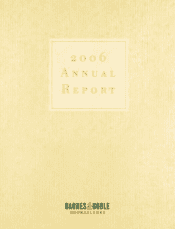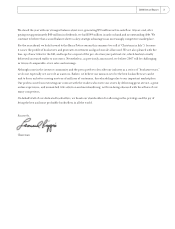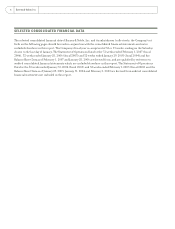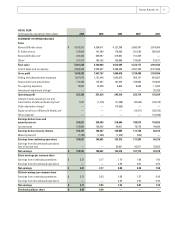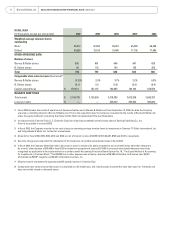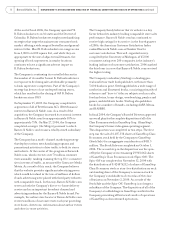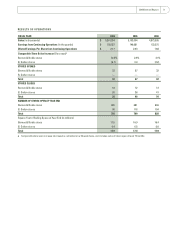Barnes and Noble 2006 Annual Report Download - page 10
Download and view the complete annual report
Please find page 10 of the 2006 Barnes and Noble annual report below. You can navigate through the pages in the report by either clicking on the pages listed below, or by using the keyword search tool below to find specific information within the annual report.
At the end of fi scal , the Company operated
B. Dalton bookstores in states and the District of
Columbia. B. Dalton bookstores employ merchandising
strategies that target the mainstream consumer book
market, off ering a wide range of bestsellers and general-
interest titles. Most B. Dalton bookstores range in size
from , to , square feet, and while they are
appropriate to the size of adjacent mall tenants, the
opening of book superstores in nearby locations
continues to have a signifi cant adverse impact on
B. Dalton bookstores.
The Company is continuing its controlled descent in
the number of its smaller format B. Dalton bookstores
in response to declining sales attributable primarily
to book superstore competition. Part of the Company’s
strategy has been to close underperforming stores,
which has resulted in the closing of B. Dalton
bookstores since .
On September , , the Company completed its
acquisition of all of Bertelsmann AG’s (Bertelsmann)
interest in Barnes & Noble.com. As a result of the
acquisition, the Company increased its economic interest
in Barnes & Noble.com from approximately to
approximately . On May , , the Company
completed a merger (the Merger) pursuant to which
Barnes & Noble.com became a wholly owned subsidiary
of the Company.
The Company has a multi-channel marketing strategy
that deploys various merchandising programs and
promotional activities to drive traffi c to both its stores
and website. At the center of this program is Barnes &
Noble.com, which receives over million customer
visits annually, ranking it among the top e-commerce
sites in terms of traffi c, as measured by Comscore Media
Metrix. As a result of this reach, the Company believes
that the website provides signifi cant advertising power
which would be valued in the tens of millions of dollars
if such advertising were placed with third party websites
with comparable reach. In this way, Barnes & Noble.com
serves as both the Company’s direct-to-home delivery
service and as an important broadcast channel and
advertising medium for the Barnes & Noble brand. For
example, the online store locator at Barnes & Noble.com
receives millions of customer visits each year providing
store hours, directions, information about author events
and other in-store activities.
The Company fi rmly believes that its website is a key
factor behind its industry leading comparable store sales
performance. Barnes & Noble.com has continued to
receive high ratings for its service: in the fourth quarter
of , the American Customer Satisfaction Index
ranked Barnes & Noble.com as Number One for
customer satisfaction. This well-regarded survey,
compiled by the University of Michigan, of ,
consumers rating over companies is the industry’s
leading indicator of customer satisfaction. marked
the third year in a row that Barnes & Noble.com received
the highest rating.
The Company’s subsidiary Sterling is a leading gen-
eral nonfi ction trade book publisher, with more than
, books in print. Sterling publishes a wide range of
nonfi ction and illustrated books, consisting primarily of
reference and “how-to” titles on subjects such as crafts,
food and wine, home design, woodworking, puzzles and
games, and children’s books. Sterling also publishes
books for a number of brands, including AARP, Mensa
and HASBRO.
In fi scal , the Company’s Board of Directors approved
an overall plan for the complete disposition of all of its
Class B common stock in GameStop Corp. (GameStop),
the Company’s former video game operating segment.
This disposition was completed in two steps. The fi rst
step was the sale of ,, shares of GameStop Class
B common stock held by the Company to GameStop
(Stock Sale) for an aggregate consideration of .
million. The Stock Sale was completed on October ,
. The second step in the disposition was the spin-
off by the Company of its remaining ,, shares
of GameStop’s Class B common stock (Spin-Off ). The
Spin-Off was completed on November , with
the distribution of . of a share of GameStop
Class B common stock as a tax-free distribution on each
outstanding share of the Company’s common stock to
the Company’s stockholders of record as of the close
of business on November , . As a result of the
Stock Sale and the Spin-Off , GameStop is no longer a
subsidiary of the Company. The disposition of all of the
Company’s stockholdings in GameStop resulted in the
Company presenting all historical results of operations
of GameStop as discontinued operations.
8 Barnes & Noble, Inc. MANAGEMENT’S DISCUSSION AND ANALYSIS OF FINANCIAL CONDITION AND RESULTS OF OPERATIONS continued

